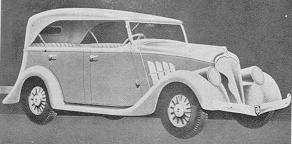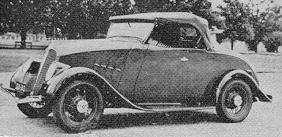
Willys 77 Tourer - Holden Bodied
In spite of being one of the cheapest, most economical and smallest of the regular production cars on the American market, it never really stood much chance of becoming a big seller as production, material purchasing, etc was limited to batches of 10,000 as allowed by the bankruptcy court. Prices for the little 4 were from from $395 upwards. The 4 door sedan was around $445 which was 13% more than the comparable 1933 Continental Beacon at $393. Development would have been severely restricted. Even so, a prototype 6 cylinder version called the Willys 99 was advertised at $595 - $695 with optional ($100 extra) sleeve valve motor but never went ahead as the production tooling was not fully completed. Tooling for the Willys 99 side valve engine was however complete and was sold to International Harvester for use in their light pick-up truck. Production totals on the restricted assembly lines over the almost 4 year period was just 67,526 (assuming all the serial no’s were used) - not much when you consider Whippet 96 volumes had averaged 11,000 vehicles per month by late 1928.
The various model years of the Willys 77 can be quickly summarised as follows;
1933 - Headlamps set in front fenders. Hood with 4 vertical doors that open. Chassis No’s 1001 to 13820. Engine No’s 1001 and up.
1934 - Hood with horizontal louvres. New floating power engine mountings. Chassis No’s 13821 to 27055.
1935 - Five circular "Port Hole" vents in hood. Headlamps mounted in apron between fenders and radiator grille (formerly integral with mudguards). Front engine rubber mounting right under water pump. Chassis No’s 27056 to 37700.
1936 - Four point rubber engine mounting. Vacuum Ignition control. Windscreens on closed cars changed from opening to non-opening. Chassis No’s 37701 to 68526.
In Feb 1936, Federal Judge George P. Hahn granted the order freeing
the company from its bankruptcy status and new development could once again
take place. Restyling and synchromesh brought the car up to date for 1937
as the Willys Model 37 with integral hood and grille hinged from the cowl.
The wheelbase remained at 100 inches but the tires were reduced to a 16
inch rim size

Willys 77 Tourer - Holden Bodied
The Willys 77 was released in Australia in April 1933 with the press calling it "a revolutionary car - putting transport on a commonsense basis".
Holden produced Sedan, Coupe, Tourer and Roadster. The roadster body
style was not available in the USA.

Willys 77 Roadster - Holden Bodied
The following Willys 77 figures are for bodies from Holden’s Woodville,
South Australian plant. Unfortunately there is no data for 1933, but as
Australia was slow to recover from the recession there would not have been
very many, if any at all.
There was also an unknown number of Utility (small commercial) vehicles
produced by Holden. These had a roadster style soft top cabin with a tray
extending to the rear instead of folding seat.
|
|
|
|
|
|
|
|
|
|
|
|
|
|
|
|
|
|
|
|
|
|
|
|
|
|
|
|
|
|
Paint colors and numbers for 1936 Holden bodied Willys 77 are listed
as:
| Blue Iridescent | 6929 |
| Hamlin Iridescent | 7318 |
| Harlequin Iridescent | 7319 |
| Rustic Green Iridescent | 7301 |
| Richmond Maroon | 6930 |
There are no paint color or code information available for the 1934
and 1935 models.

Holden Body and Trim plates (1 ½ x 2 ½ inches) - Model 77